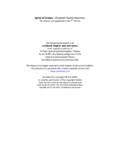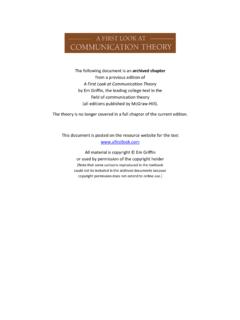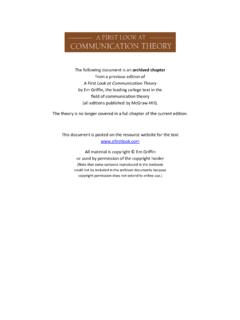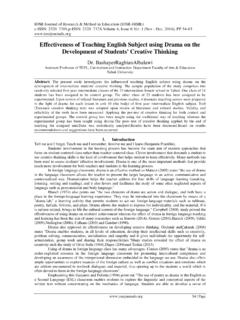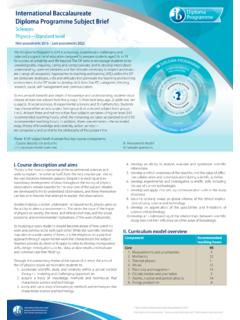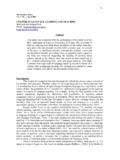Transcription of The following document is an archived chapter - A …
1 The following document is an archived chapter from a previous edition of A First Look at communication Theory by Em Griffin, the leading college text in the field of communication theory (all editions published by McGraw-Hill). The theory is no longer covered in a full chapter of the current edition. This document is posted on the resource website for the text All material is copyright Em Griffin or used by permission of the copyright holder (Note that some cartoons reproduced in the textbook could not be included in the archived documents because copyright permission does not extend to online use.). chapter 30.
2 Anxiety/Uncertainty Management Theory of William Gudykunst During a sabbatical leave from Wheaton College, I spent a month in the Philippine Islands. When a Filipino couple I knew heard that I was coming to their country, they asked me to spend a week with them on an "academic adventure." Ping and Lena were former graduate students of mine who occasionally taught at Mickel . son College, a small, church-related school in the remote province of the Davao del Sur. Lena had used a text of mine for a course at the school, and she invited me to be the commencement speaker at their graduation. The students and staff at Mickelson are Belaan Indians.
3 In addition to their na . tive tongue, they speak a dialect of Cebuano; English is their third language and is taught in the school. To get to their campus from Manila, I had to fly first on a jet, then on a prop plane. The trip continued by jeep and concluded with a six-hour pump boat ride over open water. Ping and Lena explained that the 100 students and 10 faculty members faced multiple threats of disease, violent weather, rebel in . surgency, and piracy-in that order. Located on the top of a small mountain, the school had no electricity or running water. A banner in their chapel proclaimed, "Lo, I am with you always, even unto the end of the world.
4 "] I felt I was there. ENTER THE STRANGER. Bill Gudykunst's anxiety luncertainty management (AUM) theory focuses on en . counters between cultural in-groups and strangers. Gudykunst, who died in 2005, was professor of communication at California State University, Fullerton, and he developed his interest in intergroup communication when he served as an inter . cultural relations specialist for the Navy in Japan. His job was to help naval personnel and their families adjust to living in a culture that seemed very strange to Americans. 426. chapter 30: ANXIETY/UNCERTAINTY MANAGEMENT THEORY 427. Although I've included ADM in the section on intercultural communication , Gudykunst intended his theory to apply in any situation where differences be.
5 Tween people spawn doubts and fears. For example, once a month I'm one of four men who cook breakfast, serve it, and clean up afterward at a local homeless center. I make it a point to talk with guests who show a desire for early morning conversation, but I'm never sure what topics are appropriate and I'm somewhat nervous about saying something that will embarrass them (or me). Throughout the chapter I will use the terms intergroup and intercultural interchangeably to re . flect the scope of the theory and the fact that we don't have to travel to a foreign land to either be-or encounter-a stranger. Gudykunst assumed that at least one person in an intercultural encounter is a stranger.
6 2 Through a series of initial crises, strangers experience both anxiety and uncertainty-they don't feel secure, and they aren't sure how to behave. Although strangers and ingroup members experience some degree of anxiety and uncer . tainty in any new interpersonal situation, when the encounter takes place between people of different cultures, strangers are hyperaware of cultural differences. They tend to overestimate the effect of cultural identity on the behavior of people in an alien society, while blurring individual distinctions ("When I was in the Philip . pines I noticed that all Filipinos are .."). As a stranger in a strange land, I experienced all the thoughts and feelings that Gudykunst describes.
7 But lest we get hung up on our own doubts and insecuri . ties, Gudykunst's words remind us that my hosts at Mickelson were subject to the same pangs of anxiety and uncertainty that affected me. It was a novel situation for them as well-I was only the second Caucasian visitor they'd had at their school in a decade. As an outsider within their midst, my presence was a mixed blessing. By coming from afar, I affirmed their importance yet carried the baggage of foreign values. I was physically close but brought with me strange ways of doing things. Gudykunst made it clear that ADM was always under construction. Early ac.
8 Counts cast his ideas into cause-and-effect axioms written from the standpoint of the stranger. Recent efforts flip the perspective and describe intercultural encoun . ters with strangers as experienced by members of the ingroup. In an effort to avoid the ethnocentric trap of thinking that my view of the world is the way it re . ally is, I'll illustrate Gudykunst's theory by applying it to the situation of my Philippine Belaan hosts. They wanted to bridge the culture gap through effective communication just as much as I did. EFFECTIVE communication : THWARTED BY ANXIETY AND UNCERTAINTY. Gudykunst uses the term effective communication to refer to the process of mini.
9 Mizing misunderstandings. He wrote that " communication is effective to the ex . tent that the person interpreting the message attaches a meaning to the message that is relatively similar to what was intended by the person transmitting it."3. Other authors use a variety of terms to convey the same idea-accuracy, fidelity, mutual understanding. 4 According to Gudykunst, effective communication between 428 CliLTUI,AL CONTEXT. Mickelson's president, Pol Quia, and me would not necessarily require that we draw close, share similar attitudes, or even speak with clarity-as welcome as these outcomes might be. Gudykunst would have considered our communication effec.
10 Tive if Pol and I could accurately predict and explain each other's behavior to the extent that these actions tied into our discussion. In other words, no big surprises. Figure 30-1 diagrams Gudykunst's theory of anxiety I uncertainty manage . The theory is designed to explain how effective face-to-face communica . Self-Concept Social identities f-- . Personal identities Collective self-esteem Motivation to Interact Need for predictability f-- . Need for group inclusion Need to sustain self-concept Uncertainty Management Reactions to Strangers Empathy f---- . Tolerance for ambiguity Rigid intergroup attitudes Social Categorization of Strangers Positive expectations communication I- Mindfulness Perceived personal similarities Effectiveness Understanding group differences Situation Processes Ingroup power f.


